
应用化学 ›› 2024, Vol. 41 ›› Issue (1): 109-117.DOI: 10.19894/j.issn.1000-0518.220401
基于金纳米粒子聚集与杂交链式扩增的microRNA传感
- 东北大学理学院化学系,分析科学研究中心,沈阳 110819
-
收稿日期:2022-12-12接受日期:2023-03-18出版日期:2024-01-01发布日期:2024-01-30 -
通讯作者:王建华 -
基金资助:国家自然科学基金(21974018)
MicroRNA Sensing Based on Gold Nanoparticle Aggregation and Hybridization Chain Amplification
Yang SHU, Man YANG, Zhi-Hao LI, Jian-Hua WANG( )
)
- Research Center for Analytical Sciences,Department of Chemistry,College of Sciences,Northeastern University,Shenyang 110819,China
-
Received:2022-12-12Accepted:2023-03-18Published:2024-01-01Online:2024-01-30 -
Contact:Jian-Hua WANG -
About author:jianhuajrz@mail.neu.edu.cn
-
Supported by:the National Natural Science Foundation of China(21974018)
摘要:
MicroRNA(miRNA)是癌症早期诊断的标志物,在生理和病理过程中发挥着关键作用,因此对miRNA的实时准确监测具有重要意义。目前,用于miRNA测定的信号放大/扩增策略多依赖于辅助酶的参与。本文建立了一种基于金纳米粒子(AuNPs)聚集和杂交链式反应(HCR)无酶扩增的高灵敏、特异性miRNA检测方法。为此,设计了一个辅助发夹探针(HP)和两个通用发夹探针(H1/H2),均为单链DNA(ssDNA)且具有粘性末端,可稳定水溶液中的AuNPs而有效防止盐诱导其聚集。靶miRNA与HP环区杂交,启动HCR触发双链DNA(dsDNA)聚合物的形成。dsDNA聚合物无粘性末端,对AuNPs的稳定能力减弱,从而产生盐诱导的AuNPs聚集,导致金胶体溶液由酒红色至蓝色的变化。据此可对miRNA进行光度法检测。该策略无需依赖酶促反应、分离过程及化学修饰,操作简单。通过设计HP环区序列,即可实现对不同靶标的检测,具有通用性。
中图分类号:
引用本文
舒杨, 杨曼, 李志豪, 王建华. 基于金纳米粒子聚集与杂交链式扩增的microRNA传感[J]. 应用化学, 2024, 41(1): 109-117.
Yang SHU, Man YANG, Zhi-Hao LI, Jian-Hua WANG. MicroRNA Sensing Based on Gold Nanoparticle Aggregation and Hybridization Chain Amplification[J]. Chinese Journal of Applied Chemistry, 2024, 41(1): 109-117.
| Oligonucleotide | Sequence (5'-3') |
|---|---|
| H1 | TATGGCTGGGAGTGTCGCATGCTAGCGACACTCCCA |
| H2 | GCGACACTCCCAGCCATATGGGAGTGTCGCTAGCAT |
| HP21 | GCGACACTCCCAGCCATATCAACATCAGTCTGATAAGCTATATGGCTGGG |
| HP31 | GCGACACTCCCAGCCATATCAACATCAGTCTGATAAGCTATATGGCTGGG |
| miRNA-21 | UAGCUUAUCAGACUGAUGUUGA |
| miRNA-31 | AGGCAAGATGCTGGCATAGCT |
| miRNA-let-7a | TGAGGTAGTAGGTTGTATAGTT |
| miRNA-10b | TACCCTGTAGAACCGAATTTGTG |
| miRNA-155 | TTAATGCTAATCGTGATAGGGGT |
表1 研究中所用的寡核苷酸序列
Table 1 The sequences of oligonucleotides adopted in the present study
| Oligonucleotide | Sequence (5'-3') |
|---|---|
| H1 | TATGGCTGGGAGTGTCGCATGCTAGCGACACTCCCA |
| H2 | GCGACACTCCCAGCCATATGGGAGTGTCGCTAGCAT |
| HP21 | GCGACACTCCCAGCCATATCAACATCAGTCTGATAAGCTATATGGCTGGG |
| HP31 | GCGACACTCCCAGCCATATCAACATCAGTCTGATAAGCTATATGGCTGGG |
| miRNA-21 | UAGCUUAUCAGACUGAUGUUGA |
| miRNA-31 | AGGCAAGATGCTGGCATAGCT |
| miRNA-let-7a | TGAGGTAGTAGGTTGTATAGTT |
| miRNA-10b | TACCCTGTAGAACCGAATTTGTG |
| miRNA-155 | TTAATGCTAATCGTGATAGGGGT |
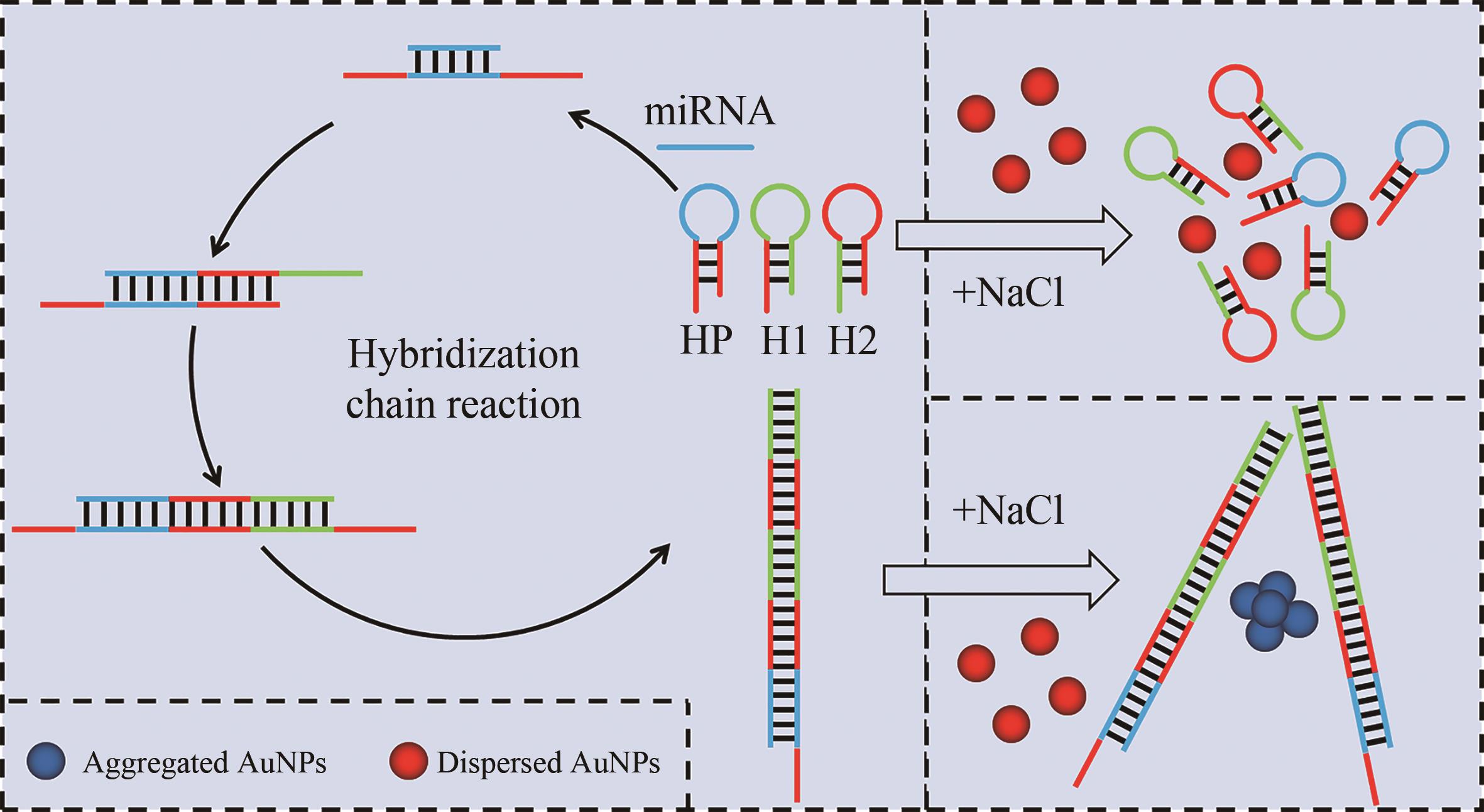
图1 基于金纳米粒子聚集状态变化和杂交链反应扩增的高灵敏比色检测miRNA原理
Fig.1 Schematic illustration for high sensitive colorimetric detection of miRNA based on the aggregation of gold nanoparticles (AuNPs) and hybridization chain reaction (HCR) amplification
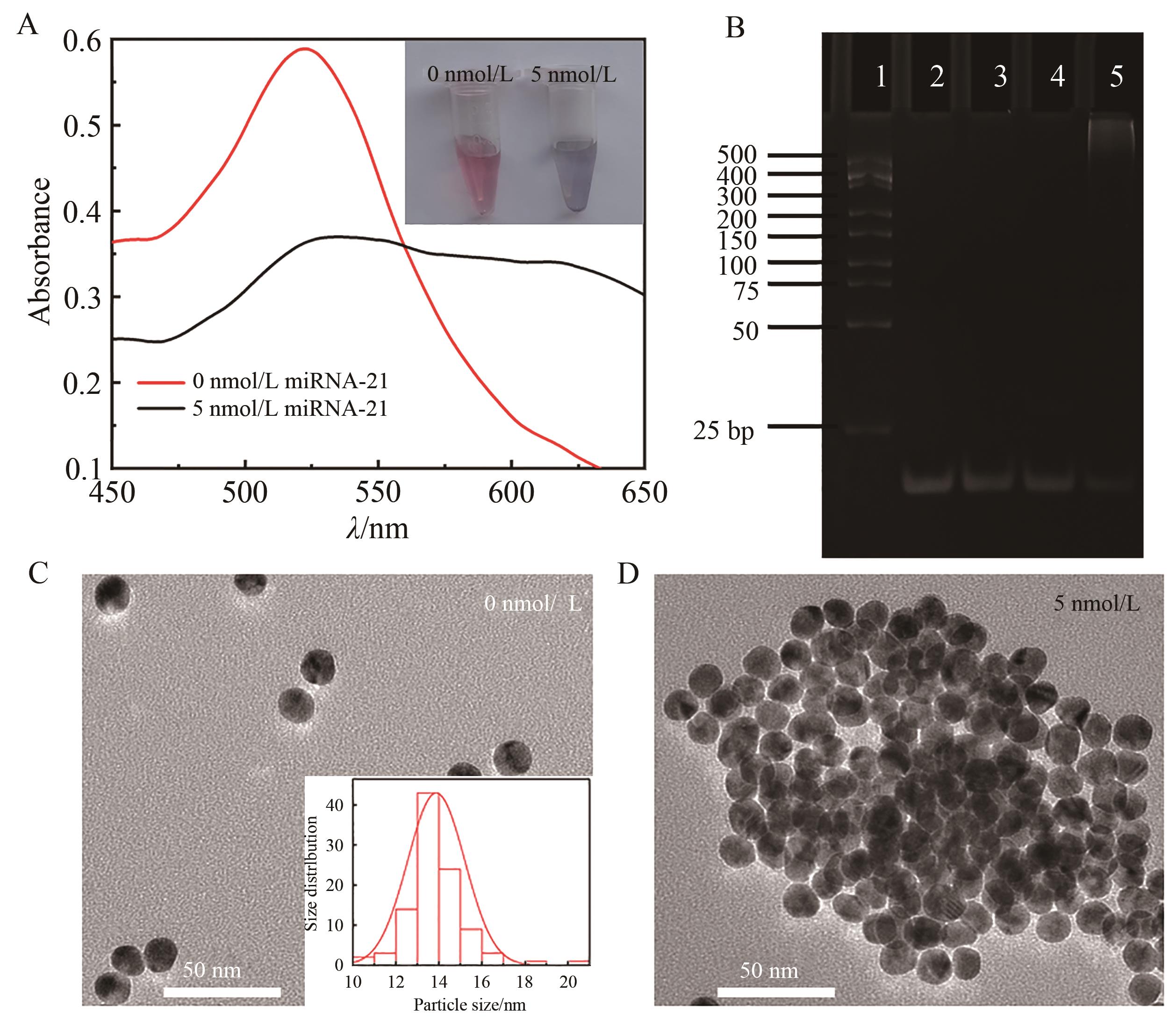
图2 (A)靶miRNA-21浓度为0和5 nmol/L时,比色检测系统的UV-Vis光谱。插图中给出的为AuNPs溶液的照片。 (B)凝胶电泳图像。从左到右的泳道: 1-DNA marker; 2-1 μmol/L H1+1 μmol/L H2; 3-1 μmol/L H1+1 μmol/L H2+50 nmol/L靶miRNA-21; 4-1 μmol/L H1+1 μmol/L H2+100 nmol/L HP21; 5-1 μmol/L H1+1 μmol/L H2+100 nmol/L HP21+50 nmol/L 靶miRNA-21。 (C)无靶miRNA-21与100 mmol/L NaCl共存时,比色检测系统的TEM图像; 插图为AuNPs的TEM粒径分布图。 (D)5 nmol/L靶miRNA-21与100 mmol/L NaCl共存时,比色检测系统的TEM图像
Fig.2 (A) UV-Vis absorption spectra for the colorimetric detection system in the absence and presence of 5 nmol/L target miRNA-21. Inset illustrated the photographs of AuNPs solution. (B) Polyacrylamide gel electrophoresis images. From left to right, lane 1: DNA marker; lane 2: 1 μmol/L H1+1 μmol/L H2; lane 3: 1 μmol/L H1+1 μmol/L H2+50 nmol/L Target miRNA-21; lane 4: 1 μmol/L H1+1 μmol/L H2+100 nmol/L HP21; lane 5: 1 μmol/L H1+1 μmol/L H2+100 nmol/L HP21+50 nmol/L Target miRNA-21. (C) TEM images of AuNPs in the absence of target miRNA-21 (The inset represents the TEM size distribution of AuNPs). (D) TEM images of AuNPs in the presence of 5 nmol/L target miRNA-21
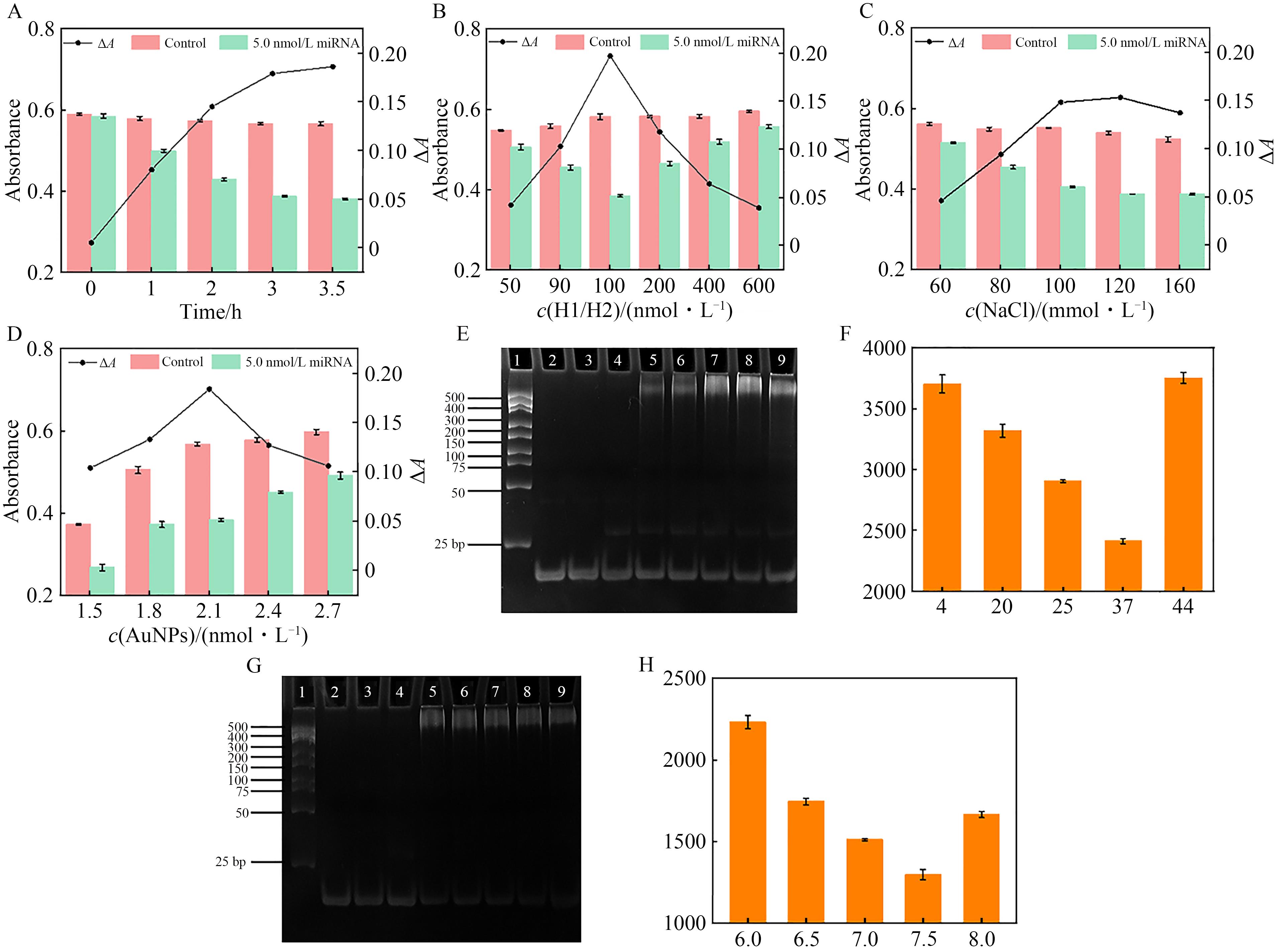
图3 (A) HCR反应时间对传感系统性能的影响。 (B) H1/H2浓度对AuNPs聚集的影响。 (C)氯化钠浓度对AuNPs聚集及比色反应的影响。 (D) AuNPs浓度对传感系统响应的影响。红色柱: 对照实验; 绿色柱: 含有5.0 nmol/L的靶miRNA。 (E)温度对HCR反应效率的影响。泳道1: DNA mark er; 2: 1 μmol/L H1+1 μmol/L H2; 3: 1 μmol/L H1+1 μmol/L H2+50 nmol/L 靶miRNA-21; 4: 1 μmol/L H1+1 μmol/L H2+100 nmol/L HP21; 5-9: 1 μmol/L H1+1 μmol/L H2+100 n mol/L HP21+50 nmol/L靶miRNA-21,对应温度依次为4、20、25、37和44 ℃。(F)图3E中泳道5-9剩余H1/H2条带的强度柱状图。 (G)缓冲溶液pH值对HCR反应效率的影响。泳道1: DNA marker; 2: 1 μmol/L H1+1 μmol/L H2; 3: 1 μmol/L H1+1 μmol/L H2+50 nmol/L靶miRNA-21; 4: 1 μmol/L H1+1 μmol/L H2+100 nmol/L HP21; 5-9: 1 μmol/L H1+1 μmol/L H2+100 nmol/L HP21+50 nmol/L靶miRNA-21,对应pH值依次为: 6.0、6.5、7.0、7.5和8.0。 (H)图G中泳道5-9剩余H1/H2条带的强度柱状图。误差线表示3次重复实验的标准偏差
Fig 3 (A) The effect of HCR reaction time on the sensing performance. (B) The effect of H1/H2 concentration on the aggregation of AuNPs and the sensing performance. (C) The effect of NaCl concentration on the aggregation of AuNPs and the performance of colorimetric reaction. (D) The effect of AuNPs concentration on the response of the sensing system. Red columns: control experiments; green columns: with 5.0 nmol/L of target miRNA. (E) The effect of temperature on HCR reaction efficiency. Lane 1: DNA marker; Lane 2: 1 μmol/L H1+1 μmol/L H2; Lane 3 1 μmol/L H1+1 μmol/L H2+50 nmol/L target miRNA-21; Lane 4: 1 μmol/L H1+1 μmol/L H2+100 nmol/L HP21; Lanes 5-9: 1 μmol/L H1+1 μmol/L H2+100 nmol/L HP21+50 nmol/L target miRNA-21 at 4, 20, 25, 37 and 44 ℃, respectively. (F) Histogram of the intensity of the residual H1/H2 bands in lanes 5-9 as indicated in Fig.3E. (G) The effect of buffer pH value on HCR reaction efficiency. Lane 1: DNA marker; Lane 2: 1 μmol/L H1+1 μmol/L H2; Lane 3: 1 μmol/L H1+1 μmol/L H2+50 nmol/L target miRNA-21; Lane 4: 1 μmol/L H1+1 μmol/L H2+100 nmol/L HP21; Lanes 5-9: 1 μmol/L H1+1 μmol/L H2+100 nmol/L HP21+50 nmol/L target miRNA-21, corresponding to pH vales of 6.0, 6.5, 7.0, 7.5 and 8.0, respectively. (H) Histogram of the intensity of the residual H1/H2 bands as indicated in lanes 5-9 in Fig.3G. The error bars represent the standard deviation of triplicate detections
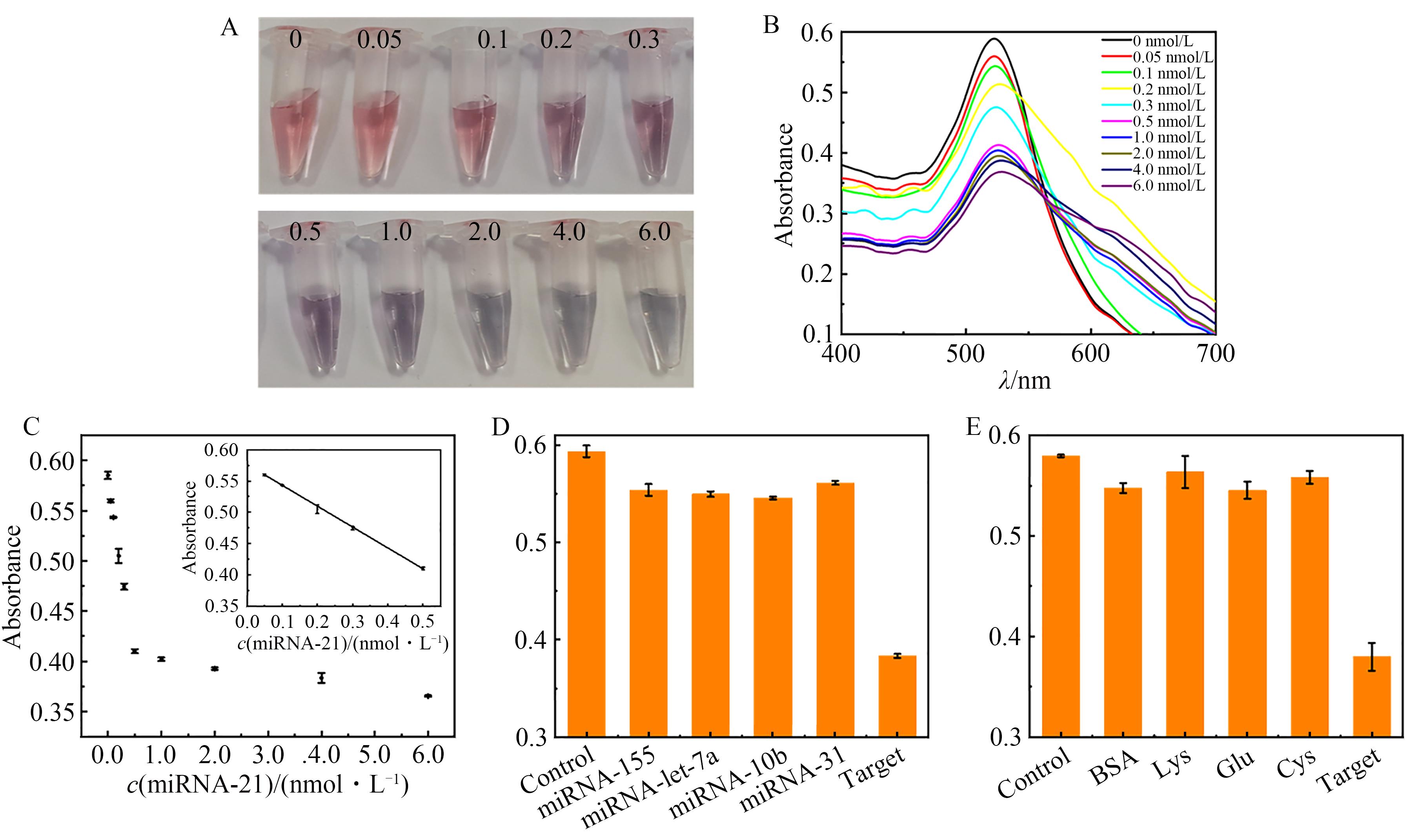
图4 (A)不同浓度靶miRNA-21存在下检测体系比色响应的照片。从左到右靶标miRNA-21的浓度依次为0、0.05、0.1、0.2、0.3、0.5、1.0、2.0、4.0和6.0 nmol/L。 (B)不同浓度靶miRNA-21存在时的紫外-可见吸收光谱,随着miRNA浓度的增大,523 nm处的吸光度明显降低。 (C)靶miRNA-21浓度与吸光度A523关系图; 插图为0.05~0.50 nmol/L浓度范围内,吸光度与miRNA浓度的线性关系。 (D)传感体系对靶miRNA-21的特异性检测。miRNA浓度为5.0 nmol/L。 (E)血清中含有的BSA、Lys、Glu和Cys等对miRNA-21测定的干扰实验。BSA、Lys、Glu和Cys的浓度分别为1 μmol/L、1 mmol/L、1 μg/mL和5 g/L。误差棒为3次重复实验的标准偏差
Fig.4 (A) The photographs of colorimetric response of the detection system in the presence of different concentrations of target miRNA-21. From left to right the concentrations of target miRNA-21were 0, 0.05, 0.1, 0.2, 0.3, 0.5, 1.0, 2.0, 4.0 and 6.0 nmol/L. (B) UV-visible absorption spectra of the sensing system in the presence of various concentrations of miRNA-21. (C) The relationship between target miRNA-21 concentration and absorbance A523 (The inset represents the linear calibration within a concentration range of 0.05~0.5 nmol/L). (D) The specific detection of target miRNA-21 by sensing system. The concentration of miRNA was 5.0 nmol/L. (E) Anti-interference test for the detection of miRNA-21 in the presence of BSA, Lys, Glu and Cys contained in serum. The concentrations of BSA, Lys, Glu and Cys were 1 μmol/L, 1 mmol/L, 1 μg/mL and 5 g/L, respectively. The error bars represent the standard deviation of three repetitive detections
| Target | Detection method | Linear range/(nmol·L-1) | Detection limit/(pmol·L-1) | Ref. |
|---|---|---|---|---|
| miRNA-21 | Colorimetric method | 0~10 | 2 600 | [ |
| miRNA-155 | Colorimetric method | 1~100 | 700 | [ |
| miRNA-146a | Colorimetric method | 0.38~40 | 1 300 | [ |
| miRNA-34c | Colorimetric method | 0~0.1 | 5 | [ |
| miRNA-let-7a | Colorimetric method | 0~400 | 63.2 | [ |
| miRNA-21 | Colorimetric method | 0.05~0.5 | 15 | This work |
表2 不同miRNA检测方法的比较
Table 2 Comparison of different miRNA detection methods
| Target | Detection method | Linear range/(nmol·L-1) | Detection limit/(pmol·L-1) | Ref. |
|---|---|---|---|---|
| miRNA-21 | Colorimetric method | 0~10 | 2 600 | [ |
| miRNA-155 | Colorimetric method | 1~100 | 700 | [ |
| miRNA-146a | Colorimetric method | 0.38~40 | 1 300 | [ |
| miRNA-34c | Colorimetric method | 0~0.1 | 5 | [ |
| miRNA-let-7a | Colorimetric method | 0~400 | 63.2 | [ |
| miRNA-21 | Colorimetric method | 0.05~0.5 | 15 | This work |
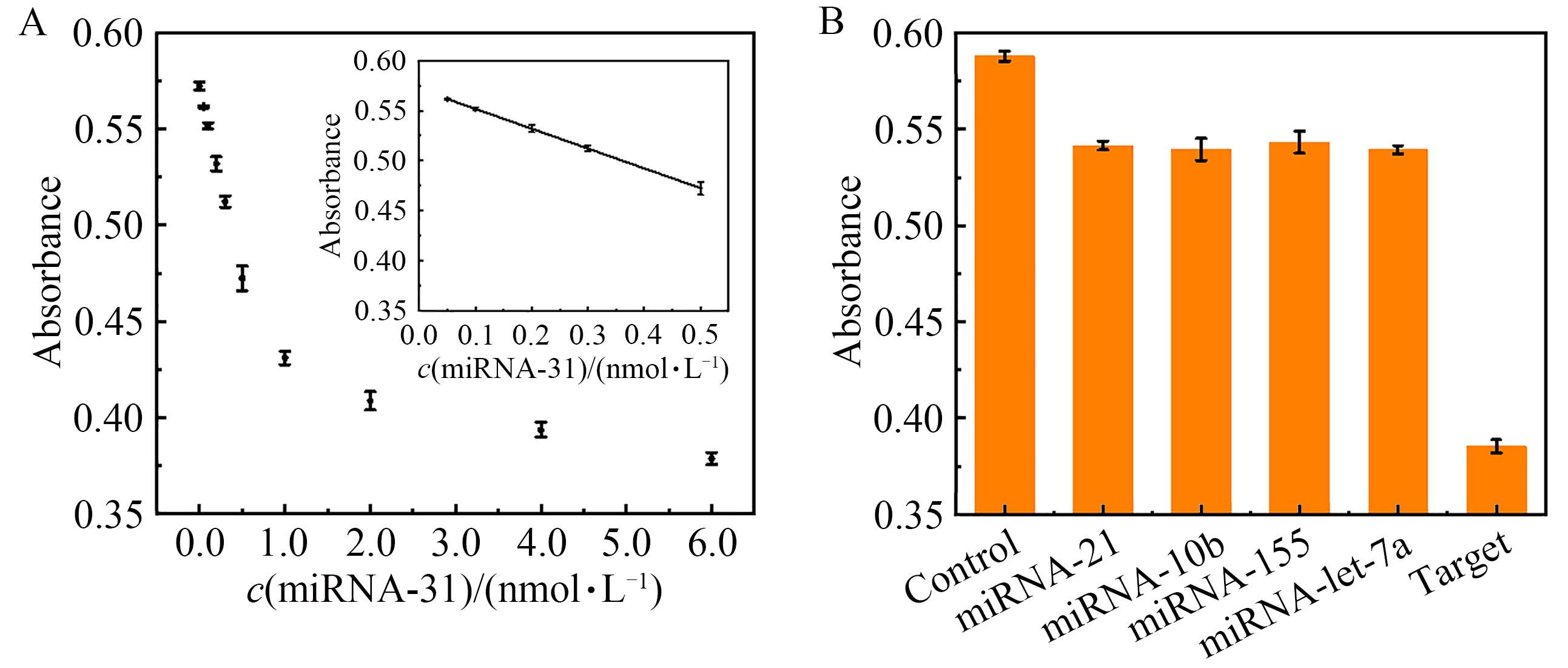
图5 (A)靶miRNA-31的浓度与吸光度A523关系图; 插图为0.05~0.50 nmol/L浓度范围内,靶miRNA-31浓度与吸光度之间的线性关系。 (B)传感体系对靶miRNA-31的特异性检测。miRNA浓度为5.0 nmol/L
Fig.5 (A) The relationship between target miRNA-31 concentration and absorbance A523 (The inset represents the linear calibration within a concentration range of 0.05~0.50 nmol/L). (B) The specific detection of target miRNA-31 by the sensing system. The concentration of miRNA was 5.0 nmol/L
| Target | Sample | Added/(pmol·L-1) | Found/(pmol·L-1) | Recovery/% | RSD/% |
|---|---|---|---|---|---|
| miRNA-21 | 1 | 50 | 55.8 | 112 | 2.3 |
| 2 | 100 | 104.7 | 105 | 1.7 | |
| 3 | 150 | 146.3 | 98 | 1.2 | |
| miRNA-31 | 1 | 50 | 45.5 | 91 | 1.8 |
| 2 | 100 | 101.0 | 101 | 2.7 | |
| 3 | 150 | 166.7 | 111 | 2.1 |
表3 稀释的人血清样品中miRNA-21与miRNA-31的测定与回收率(n=3)
Table 3 The spiking recovery of miRNA-21 and miRNA-31 in diluted human serum samples (n=3)
| Target | Sample | Added/(pmol·L-1) | Found/(pmol·L-1) | Recovery/% | RSD/% |
|---|---|---|---|---|---|
| miRNA-21 | 1 | 50 | 55.8 | 112 | 2.3 |
| 2 | 100 | 104.7 | 105 | 1.7 | |
| 3 | 150 | 146.3 | 98 | 1.2 | |
| miRNA-31 | 1 | 50 | 45.5 | 91 | 1.8 |
| 2 | 100 | 101.0 | 101 | 2.7 | |
| 3 | 150 | 166.7 | 111 | 2.1 |
| 1 | MALUMBRES M. MiRNAs and cancer: an epigenetics view[J]. Mol Aspects Med, 2013, 34(4): 863-874. |
| 2 | KORNFELD S F, CUMMINGS S E, FATHI S, et al. MiRNA-145-5p prevents differentiation of oligodendrocyte progenitor cells by regulating expression of myelin gene regulatory factor[J]. J Cell Physiol, 2020, 236(2): 997-1012. |
| 3 | ROTIVAL M, SIDDLE K J, SILVERT M, et al. Population variation in miRNAs and isomirs and their impact on human immunity to infection[J]. Genome Biol, 2020, 21(1): 187. |
| 4 | ZHOU Z, FAN D, WANG J, et al. Triggered dimerization and trimerization of DNA tetrahedra for multiplexed miRNA detection and imaging of cancer cells[J]. Small, 2021, 17(6): 200735. |
| 5 | LEMPRIERE S. Exosomal microRNA is promising biomarker in PD[J]. Nat Rev Neurol, 2022, 18(2): 65. |
| 6 | WU Y, CUI S, LI Q, et al. Recent advances in duplex-specific nuclease-based signal amplification strategies for microRNA detection[J]. Biosens Bioelectron, 2020, 165: 112449. |
| 7 | BING Z T. Triple signal amplification strategy for ultrasensitive determination of miRNA based on duplex specific nuclease and bridge DNA-gold nanoparticles[J]. Anal Chem, 2018, 90(3): 2395-2400. |
| 8 | QIANG L A, MEI L B, YAN J A, et al. Rapid and enzyme-free signal amplification for fluorescent detection of microRNA via localized catalytic hairpin assembly on gold nanoparticles[J]. Talanta, 2021, 242: 123142. |
| 9 | ZHU Y, WANG J, XIE H. NIR-to-vis handheld platforms for detecting miRNA level and mutation based on sub-10 nm sulfide nanodots and HCR amplification[J]. ACS Appl Mater Interfaces, 2022, 14(8): 10212-10226. |
| 10 | BAI M, CHEN F, CAO X, et al. Intracellular entropy-driven multi-bit DNA computing for tumor progression discrimination[J]. Angew Chem Int Ed, 2020, 59(32): 13267-13272. |
| 11 | YANG Y, YANG J, GONG F, et al. Combining CRISPR/Cas12a with isothermal exponential amplification as an ultrasensitive sensing platform for microRNA detection[J]. Sens Actuators B: Chem, 2022, 367: 132158. |
| 12 | HUANG J, SHANG G J F, GUO Q P, et al. Colorimetric and fluorescent dual-mode detection of microRNA based on duplex-specific nuclease assisted gold nanoparticle amplification[J]. Analyst, 2019, 144(16): 4917-4924. |
| 13 | DIRKS R M, PIERCE N A. Triggered amplification by hybridization chain reaction[J]. PANS, 2004, 101(43): 15275-15278. |
| 14 | SAISUK W, SUKSAMAI C, SRISAWAT C, et al. The helper oligonucleotides enable detection of folded single-stranded DNA by lateral flow immunoassay after HCR signal amplification[J]. Talanta, 2022(248): 123588. |
| 15 | ZHAO K, PENG Z, JIANG H, et al. Shape-coded hydrogel microparticles integrated with hybridization chain reaction and a microfluidic chip for sensitive detection of multi-target miRNAs[J]. Sens Actuators B: Chem, 2022, 361: 131741. |
| 16 | DANIEL M C, ASTRUC D. Gold nanoparticles: assembly, supramolecular chemistry, quantum-size-related properties, and applications toward biology, catalysis, and nanotechnology[J]. Chem Rev, 2004, 104(1): 293-346. |
| 17 | ZHEN M Z, XIN M, MIAO P. Roll-to-roll DNA nanomachine for ultrasensitive electrochemical determination of miRNA[J]. Langmuir, 2022, 38(36): 11130-11135. |
| 18 | GRABAR K C, FREEMAN R G, HOMMER M B, et al. Preparation and characterization of Au colloid monolayers[J]. Anal Chem, 1995, 67(4): 735-743. |
| 19 | CAO J, LV P, SHU Y, et al. Aptamer/AuNPs encoders endow precise identification and discrimination of lipoprotein subclasses[J]. Biosens Bioelectron, 2021, 196: 113743. |
| 20 | BOMI S, JISEON P, HANGSUK C, et al. A fluorescence/colorimetric dual-mode sensing strategy for miRNA based on graphene oxide[J]. Anal Bioanal Chem, 2020, 412(1): 233-242. |
| 21 | KOSAR S, EHSAN S, MORTEZA H. Sensitive colorimetric detection of miRNA-155 via G-quadruplex DNAzyme decorated spherical nucleic acid[J]. Mikrochim Acta, 2022, 189: 357. |
| 22 | SANCHEZ V A, LOSADA M J, SOLDADO C A, et al. A portable device for miRNAs detection based on a gold-nanoparticle ratiometric colorimetric strategy[J]. IEEE Trans Instrum Meas, 2022, 71: 7006009. |
| 23 | MOTOI O, SATOMI S. An efficient particle‐based DNA circuit system: catalytic disassembly of DNA/PEG-modified gold nanoparticle-magnetic bead composites for colorimetric detection of miRNA[J]. Small, 2016, 12(37): 5153-5158. |
| 24 | HUO X, FENG L Y, DAN L C, et al. Trigging stepwise-strand displacement amplification lights up numerous G-quadruplex for colorimetric signaling of serum microRNAs[J]. iScience, 2023, 26(4): 106331. |
| 25 | 杨培, 张龙飞, 田宇,等. 生物样品测定分析方法中提取回收率的探讨[J]. 中华中医药杂志, 2015, 30(3): 722-726. |
| YANG P, ZHANG L F, TIAN Y, er al. Discussion of recovery in biological sample determination methodology[J]. China J Tradit Chin Med Pharm, 2015, 30(3): 722-726. |
| [1] | 徐一, 林梦瑶, 宫晓群. 多色比色法在生物传感平台的研究进展[J]. 应用化学, 2024, 41(1): 3-20. |
| [2] | 仝大伟, 孔明, 向育斌. 含甲氧基四苯乙烯咪唑化合物的合成、光物理性质、理论计算及细胞成像[J]. 应用化学, 2023, 40(9): 1322-1329. |
| [3] | 杨悦, 黄诗雯, 佟玥, 陈泽达, 马本华, 窦传冬. 推拉电子结构手性四配位硼的光学性质[J]. 应用化学, 2023, 40(5): 743-748. |
| [4] | 张鼎, 杨微微, 缪嵩松, 苏怡. 含氮多孔碳限域金纳米粒子用于电化学检测液相二氧化氯[J]. 应用化学, 2023, 40(11): 1572-1580. |
| [5] | 王后臣, 周利, 刘洋, 陈明月, 石铁生. 超分子聚集体构筑单元的分子设计及其自组装研究进展[J]. 应用化学, 2021, 38(6): 615-621. |
| [6] | 陈松华, 陈欣, 刘永琦, 何美云, 付珊珊, 彭丽, 杨纪恩. 以咔唑为给体的分子内电荷转移化合物的自组装及发光性质[J]. 应用化学, 2020, 37(9): 1022-1029. |
| [7] | 张艳平, 薛冬峰. 钠和钾离子对磷酸二氢根拉曼光谱的影响[J]. 应用化学, 2020, 37(7): 823-829. |
| [8] | 李昕翼,王小华,周晓东,胡继明. 基于多肽-金纳米粒子复合物的生物传感研究及应用进展[J]. 应用化学, 2019, 36(5): 489-499. |
| [9] | 程金华, 姜鸿基. 末端四苯乙烯荧光团标记法研究双亲性嵌段聚合物的自组装行为[J]. 应用化学, 2019, 36(4): 440-450. |
| [10] | 党利芳,王蕊欣,谢美娜,焦纬洲. 多金属氧酸盐及其溶液自聚集行为研究进展[J]. 应用化学, 2018, 35(6): 625-644. |
| [11] | 马莉,徐经伟,杨传崎,李云辉,马玉芹,赵永霞. 笼形倍半硅氧烷修饰的金纳米粒子对4-正戊基4'-氰基联苯液晶性能的影响[J]. 应用化学, 2018, 35(11): 1378-1383. |
| [12] | 王涛,马拉毛草,马恒昌. 基于聚集诱导发光荧光探针的细胞成像研究进展[J]. 应用化学, 2018, 35(10): 1155-1165. |
| [13] | 李悦青,吴茜茜,宋其玲,曹雷,秦秋燕,徐艳,赵伟杰. 肉桂酰酪胺类似物的合成与抗血小板聚集评价[J]. 应用化学, 2018, 35(10): 1174-1183. |
| [14] | 李悦青, 吴茜茜, 宋其玲, 曹雷, 秦秋燕, 徐艳, 赵伟杰. 肉桂酰酪胺类似物的合成与抗血小板聚集评价[J]. 应用化学, 2018, 35(10): 0-0. |
| [15] | 石伟宁,徐勇前,孙世国,李红娟. 方酸菁荧光探针的应用研究进展[J]. 应用化学, 2017, 34(12): 1433-1449. |
| 阅读次数 | ||||||
|
全文 |
|
|||||
|
摘要 |
|
|||||